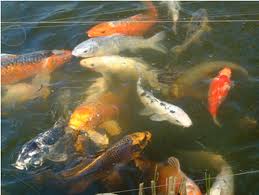





One of the most enjoyable, yet controversial, issues for the pool owner is the feeding of fish. Is it necessary? How often should you do it? And what should you use? If you are a fish enthusiast, your choice of foods may be as diverse as those for a pet cat or dog, but if the pool is essentially a wildlife habitat, provided all is well, the fish may not require much feeding at all.
While it is not necessary to feed decorative fish in a well balanced pool, there can be few water gardeners who are not fascinated by the prospect of regularly feeding them and watching their antics. Like most other domesticated creatures, fish will not go seeking food if it is provided for them; once a routine has been established, a footfall close by the pool or a shadow cast across the water will bring the fish to the surface in the expectation of being fed. However, if you intend feeding them regularly, it is important to use a balanced and nutritious food:
Unquestionably, stick fish foods are the easiest to handle and, if you select a quality brand, the best balanced for pond fish. They have the advantage of floating on the water for a considerable period of time, so if the fish have not devoured them within ten minutes, any remaining food can be netted and removed. This prevents uneaten food from settling on the floor of the pool, where it will decompose unpleasantly. Although the sticks may seem rather large for some of the smaller fish, remember that the fish will suck at them rather than gulp them down in one go,although this inevitably happens with some of the larger fish.
 Flaked fish food is also excellent and mostly scientifically balanced. There are specific cold-water flakes, and some companies manufacture a special formulation for the pool.
Flaked fish food is also excellent and mostly scientifically balanced. There are specific cold-water flakes, and some companies manufacture a special formulation for the pool.
They are much loved by goldfish, and easily taken by very small fish, but unless feeding is undertaken on a still day, the flakes can end up in the herbaceous border, rather than the pool. They also float for much less time than the sticks, yet are likely to cause almost as much contamination of the water if allowed to sink. A careful eye needs to be kept on the flakes to ensure the prompt removal of any that remain uneaten.
Enthusiastic fish keepers occasionally like to feed some live food during the summer months. If you can spare a little time, feeding live food to your fish will certainly be worthwhile from their point of view. Most fish have regular access to live food, although this is often obtained naturally by preying on aquatic insect life in the pool. The occasional provision of a tasty morsel of earthworms or daphnia, however, will be much appreciated. Earthworms are a natural treat that can be easily collected in most gardens. Avoid worms from areas that have been treated with chemicals, however, as these could harm the fish.
Daphnia, or water fleas, are a very different proposition. These can be cultured quite easily, making it possible to maintain a fresh supply of live food throughout the summer with little effort. Daphnia may often be found naturally in ponds, water butts and, on occasion, even large puddles. However, a culture can be purchased from an aquatics supplier and perpetuated in a tub or barrel. All that is required is a layer of soil about 2.5cm (1in) deep, the addition of rainwater, although conditioned tap water will also suffice, and the introduction of the daphnia. Under such conditions, they will prosper, and small quantities can be gathered with a fine muslin net each week as a live treat for the fish.
The necessity of feeding fish is a continual bone of contention among fish keepers, and there is no consensus of opinion. By and large, however, in a sparsely stocked pool, if you want to feed the fish, there will be benefits, but if you do not, the fish are still likely to grow and flourish on the natural food within the pool.
During the winter, the metabolism of pool fish slows down and they do not require regular feeding when the temperature is below 5°C (41°F). During this cold period, the fish rely on their stored food reserves. However, recent research has shown that feeding a wheatgerm-based food during mild spells, when the temperature rises above 5°C (41°F), will preserve their food reserves and ensure that they are strong and healthy at the end of the cold period. Feed the fish on a few food sticks whenever they are active and rise to the surface in search of food.
As the water temperature rises in the spring, the fish will become more -active and should be fed more regularly. Feed as much as they will consume within ten minutes each day.
In the summer, the fish will feed actively and can be given higher-protein foods to encourage growth, and foods containing colour enhancers to promote good body coloration. Again, feed as much as the fish will consume in ten minutes, once or twice a day. This amount will be much greater than in the spring.
Copyright © www.100flowers.win Botanic Garden All Rights Reserved